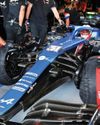
Shortly before the 50th anniversary of Porsche’s first win at Le Mans, the German company reported the death of Hans Mezger, the man who designed the engine for that Porsche 917, and who was instrumental in the development of many significant Porsche racing and road car engines. Mezger was also responsible for the engine that powers what’s commonly known as the Porsche 911 and was so highly regarded that those are known today as the Mezger engines.
Hans Mezger was born on November 18, 1929, in Ottmarsheim, a small village near Ludwigsburg on the outskirts of Stuttgart. At the age of 15, just three weeks before the end of the war, he escaped being enlisted into the German army by a stroke of luck and a faked medical certificate from a German commander. A year later, while continuing his grammar school studies, he attended his first race at Hockenheim.
Having taken his A-levels in Ludwigsburg, Mezger decided to study mechanical engineering at the Technical University, now the University of Stuttgart. However, at this time the German universities were very crowded because the young men who had returned from the war were given preferential treatment for admission.
When he reached the required age, he used the university requirement for a 12-month internship to gain valuable experience in machining, welding and model making and spent a few weeks in the grey cast iron and aluminium foundry.
‘At that time I was riding a motor scooter, an NSU Lambretta,’ he recalled in an interview. ‘I rode the Lambretta until 1960 when I bought my first car, an old and quite worn out [Porsche] 356… It was not until years later that I came into contact with motorised two-wheelers again when in the late 1970s it became necessary to develop new motorcycle engines for Harley-Davidson.’
This story is from the August 2020 edition of Racecar Engineering.
Start your 7-day Magzter GOLD free trial to access thousands of curated premium stories, and 8,500+ magazines and newspapers.
Already a subscriber ? Sign In
This story is from the August 2020 edition of Racecar Engineering.
Start your 7-day Magzter GOLD free trial to access thousands of curated premium stories, and 8,500+ magazines and newspapers.
Already a subscriber? Sign In
Talk the torque
More thoughts on in-wheel motors and their effects on twisting force
Rolling about
An explanation of the limitations of a previous load transfer article, bringing jacking forces into the mix
F1 breaks schedule records
The FIA has confirmed no fewer than 23 races on the 2022 Formula 1 World Championship schedule, the highest number of grands prix ever to be held in a single season, and that has led to criticism from some teams that will be on the road for eight months.

Under pressure
Toyota may have finished first and second at Le Mans this year, but the effort required to overcome a fuel delivery problem and finish with both cars was Herculean
Physics at work
Dutch company, Intrax, offers Racecar Engineering an insight into the technologies it employs to optimise its suspension products
Williams' 2030 ambition
Williams Racing has committed to becoming climate positive by 2030 as part of an all-new sustainability strategy.
Diff'rent strokes
Racecar looks at the different types of mechanical differential, their benefits and limitations
Das Boot
A curious Twitter exchange fired up a unique, hydrogen-powered, cross-country project that will contest the Baja 1000 in November 2022

Air born
Every racecar engineer's dream is a blank sheet of paper design. When Hoonigan and Subaru approached Vermont Sportscars about building the next generation of Gymkhana racer, that's just what the company was given

Remote control
Called variously ‘virtual garages’, ‘mission control’ or ‘race support rooms’ is the future of race engineering sitting in the warm back at HQ?